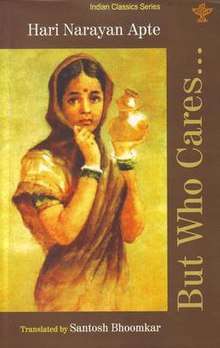Pan Lakshat Kon Gheto
Pan Lakshat Kon Gheto (Marathi: पण लक्षात कोण घेतो?, English: But Who Cares...) is an 1890 Marathi novel by Hari Narayan Apte. Written in autobiographical style, the novel tells the story of Yamuna, a young Hindu middle-class woman, who dies after suffering the injustices of a society where child marriage is customary. It is considered to be a classic novel in Marathi literature.
 Cover of English translation | |
| Author | Hari Narayan Apte |
|---|---|
| Original title | पण लक्षात कोण घेतो? |
| Translator | Santosh Bhoomkar |
| Country | India |
| Language | Marathi |
| Genre | Social novel, autobiographical novel |
Publication date | 1890 |
Published in English | 2015 |
| OCLC | 922565313 |
Background
Pan Lakshat Kon Gheto was first published in 1890.[1] Prior to this work, novels were written and read for "entertainment and instruction." Pan Lakshat Kon Gheto, which unveiled the lives of child widows, was a significant departure from this methodology.[2]
Plot
The novel was written in the form of an autobiography from the perspective of a young widow, Yamuna.[3] The story spans the life of Yamuna and the reader is introduced to the many people in her life—nearly 40 characters.[2]
Yamuna's story begins with a short-lived but idyllic childhood. Although happy, it was darkened by the fear Yamuna's mother and grandmother shared over their insecurity as dependents. At twelve she is married to a young man, Raghunathrao. He is liberal and wants to make Yamuna but he is unable to change her family circumstances. Yamuna is tortured by her in-laws and denied freedom of any kind.[3]
When Yamuna's mother dies, her father promptly remarries, this time to a twelve-year-old girl. Her brother's stupid wife makes a hell of Yamuna's married life and although Yamuna and her brother, Ganpatrao, are very affectionate towards each other, there is no happiness in their father's house. Yamuna and her husband move to Bombay where they both find some happiness. In Bombay she meets some reformist families who show her what it's like to have freedom. While there, Yamuna frees her friend Durga from her depraved husband and her brother comes to stay with her to continue his education.[3]
Yamuna's husband dies after a brief illness and her happiness and freedom are suddenly over. Yamuna is forced to return to her father-in-law in Shanker, who has now married a young girl of twelve. Yamuna's in-laws rob her of her gold and forcefully shave her head in the name of sacred custom (tonsure). Her brother cannot do anything to protect her. She dies some time after having written her life story.[3]
Reception
The novel is considered to be a classic, sometimes referred to as a feminist classic, in Marathi literature[4] and had a major effect on Hindu reform movements.[5]
Pan Lakshat Kon Gheto? This novel is the first of its kind and still remains unsurpassed in many ways. It is cast in the form of the autobiography of a widow. It is written in a style which is appropriately womanly, and chaste, if also meandering. For the first time in Marathi fiction a character is portrayed dynamically and in all its dimensions.
Pan Lakshat Kon Gheto was translated into English by Santosh Bhoomkar as But Who Cares... (2015), published by Sahitya Akademi.[4] P. V. Narasimha Rao translated it into Telugu as Abala Jeevitam.[7][8][9] Leela Karanth also translated the novel into Kannada.[10] The Gujarati translation by Gopalrao Vidwans was published in 1975 under the title Mari Karamkathani.[11]
References
- Yogendra K. Malik (1981). South Asian Intellectuals and Social Change: A Study of the Role of Vernacular-speaking Intelligentsia. New Delhi: Heritage Publishers. p. 53. OCLC 9079573.
- Amaresh Datta; Mohan Lal (2007). Encyclopaedia of Indian Literature: Navaratri-Sarvasena (4th ed.). New Delhi: Sahitya Akademi. p. 3057. ISBN 978-81-260-1003-1.CS1 maint: ignored ISBN errors (link)
- George, K. M., ed. (1993). Modern Indian Literature: an Anthology: Fiction. Vol. 2. New Delhi: Sahitya Akademi. pp. 687–688. ISBN 81-7201-506-2.
- Roy, Devapriya (2017-03-19). "Fourteen Marathi classics, handpicked by Bhalchandra Nemade, that must be read (and translated)". Scroll.in. Retrieved 2018-12-10.
- Simon Weightman (1996). Indian Subcontinent. Passport Books. p. 198. ISBN 978-0-8442-8970-0.
- Deśapāṇḍe, Kusumāvatī; Rājādhyaksha, Maṅgeśa Viṭṭhala (1988). A History of Marathi Literature. New Delhi: Sahitya Akademi. pp. 88–89. OCLC 19585943.
- Rajendra Kumar. President and Prime Minister of India. Prabhat Prakashan.
- S. Gajrani, ed. (2004). History, Religion and Culture of India: History, Religion and Culture of Western India. 3. Delhi: Isha Books. p. 264. ISBN 978-81-8205-062-4.
- S. C. Bhatt; Gopal K. Bhargava, eds. (2006). Land and People of Indian States and Union Territories: Maharashtra. 16. Delhi: Kalpaz Publications. p. 234. ISBN 978-81-7835-372-2.
- Ramachandran, C. N. (2001). K. Shivarama Karanth. New Delhi: Sahitya Akademi. p. 16. ISBN 978-81-260-1071-4.
- Rao, D. S. (2004). Five Decades: The National Academy of Letters, India : a Short History of Sahitya Akademi. New Delhi: Sahitya Akademi. p. 48. ISBN 978-81-260-2060-7.